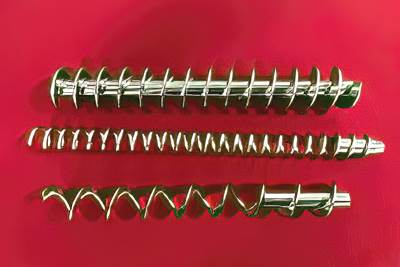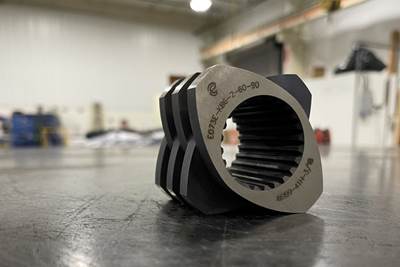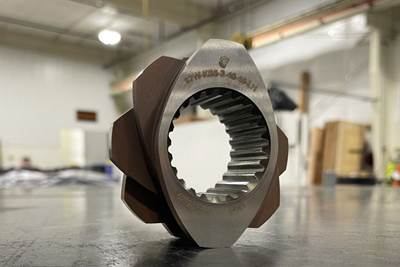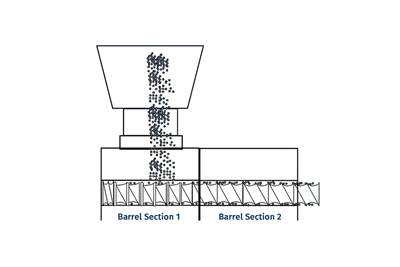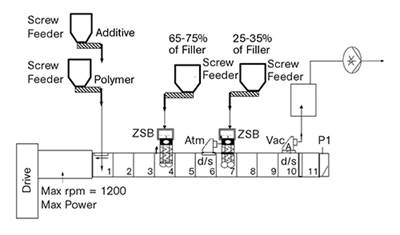Compounding
In compounding, various materials (polymers, additives, etc.) are mixed and melted—generally in an extruder of some type—then pelletized. Most compounding extruders purchased nowadays are of the twin-screw corotating/intermeshing variety, though counterrotating twins are used for some applications. Compounding extrusion lines are typically equipped with gravimetric feeding systems that dose materials into the extruders at very specific rates. In certain applications, extruders are equipped with vent ports that pull unwanted moisture and other volatiles from the polymer stream.

Narrow Your Compounding Search
ESSENTIAL READING
VIEW ALLHow to Configure Your Twin-Screw Barrel Layout
In twin-screw compounding, most engineers recognize the benefits of being able to configure screw elements. Here’s what you need to know about sequencing barrel sections.
Read MoreWhat to Know About Your Materials When Choosing a Feeder
Feeder performance is crucial to operating extrusion and compounding lines. And consistent, reliable feeding depends in large part on selecting a feeder compatible with the materials and additives you intend to process. Follow these tips to analyze your feeder requirements.
Read MoreHow to Configure Your Twin-Screw Extruder for Mixing: Part 5
Understand the differences between distributive and dispersive mixing, and how you can promote one or the other in your screw design.
Read MoreHow to Configure Your Twin-Screw Extruder: Part 3
The melting mechanism in a twin-screw extruder is quite different from that of a single screw. Design of the melting section affects how the material is melted, as well as melt temperature and quality.
Read MoreHow to Configure Your Twin-Screw Extruder -- Part 2
Follow these tips to configure your twin-screw elements to promote feeding and solids conveying.
Read MoreImproving Twin-Screw Compounding of Reinforced Polyolefins
Compounders face a number of processing challenges when incorporating a high loading of low-bulk-density mineral filler into polyolefins. Here are some possible solutions.
Read MoreLatest Compounding News And Updates
Mixer, New Pelletizer Facilitate Rigid PVC Compounding
Farrel Continuous Mixer and newly designed Dry Face Pelletizer combine to eliminate traditional finishing steps to make rigid PVC processing more efficient.
Read MoreRoss Reducing Prices on Batch High-Shear Mixers
Base prices of Series 100 and Series 500 Production Batch High Shear Mixers reduced by up to 40%.
Read MoreCoperion Moves to Streamline US Operations
Machine builder is relocating Salina operation to existing facilities in Kansas, Wisconsin and Missouri.
Read MoreGeon Buys Medical Compounder Foster
Move intended to broaden GEON’s portfolio in the medical market.
Read MoreDual-Shaft Mixer for Robust Industrial Mixing
Units are engineered for wide-ranging densities and viscosities up to several hundred thousand centipoise.
Read MoreFixed Tank Dual Shaft Mixer/Pressure Reactor
This mixer is said to be well suited for processes that require meticulous control over mixing, temperature and pressure in a compact and portable module.
Read MoreFeatured Posts
Optimizing Melt-Fed Single-Screw Extruders on Compounding Lines
The main problem with melt-fed extruders that are starve-fed is setting the depth of the metering channel. In this scenario, we describe how this problem was solved.
Read MoreUnderstanding 'Boundary Conditions' in Twin-Screw Compounding
In twin-screw compounding, the objective is generally to produce the highest quality product at the maximum strand. But sometimes there are operating parameters that prevent this objective from being realized.
Read MoreHow to Configure Your Twin-Screw Barrel Layout
In twin-screw compounding, most engineers recognize the benefits of being able to configure screw elements. Here’s what you need to know about sequencing barrel sections.
Read MoreResearch Deems Bioplastics, Wood Pulp a Sustainable, Economic Alternative for Rigid Packaging
Farrel Pomini and FPInnovations produce biodegradable compound for molding, extrusion and thermoforming applications.
Read MoreWhat to Know About Your Materials When Choosing a Feeder
Feeder performance is crucial to operating extrusion and compounding lines. And consistent, reliable feeding depends in large part on selecting a feeder compatible with the materials and additives you intend to process. Follow these tips to analyze your feeder requirements.
Read MoreSirmax Adapts Integrated Recycling Approach to US Supply Conditions
Integrating compounding and recycling to leverage untapped postindustrial recycling feedstocks.
Read MoreFAQ: Compounding
How can I optimize my twin-screw compounding process?
We identify problems in compounding as “chronic” if the results are the same every time a particular formulation is run. For these problems, the treatment requires redesigning the screw configuration or modifying the compounding process. This is the only way to cure such problems.
Many new players have emerged in the biopolymer space with new materials and many new formulations. Co-rotating twin-screw extruders provide excellent material mixing capabilities for all polymers, including biopolymers. You should consider your machinery supplier as a development partner to achieve your goals in the areas of melt and mix quality, production rates, and other parameters, regardless of formulation. Make sure your machinery supplier has the facilities and the know-how to help you test material formulations and improve your processes.
Pelletizers are essential components in resin manufacture, compounding, masterbatch production, and recycling. A high-volume system that is appropriate for a polymerization plant will be very different from one that suits the needs of a toll compounder. One that can produce micropellets for use in masterbatch may not be the best choice for processing post-consumer regrind. Here are some different types of pelletizers.
- UNDERWATER PELLETIZERS
- WATERRING PELLETIZERS
- STRAND PELLETIZERS
Compounding Supplier Categories
- Rebuilt Screws or Barrels
- Blenders (non-intensive)
- Automation/Systems Integration
- Web Winders, Unwinds, Rewinds
- Single-Screw Extruders
- Plastics Recycling - Purchasing Scrap or Waste Plastics
- Custom Compounding, Formulating - Thermoplastics
- Barrier Surface Treatment
- Liquid Mixers
- Plastics Machine Alignment Services
- Mold/Tooling Design Services
- Mold/Tooling Design Services
- Slot Orifice Coaters
- Plastics Processing Machinery Rebuilding
- Sheet Take-off Systems
- Film Take-off Systems
- Web Brakes, Clutches, Chucks
- Extrusion Dies
- Shipping & Logistics
- Universities, Colleges & Research Centers
- Web Inspection Systems
- Rebuilt Motors & Drives
- Pipe Take-off Systems
- Web Guides, Edge Detectors
- Wire & Cable Take-off Systems
- Pipe Thickness Measuring Equipment
- Roll Coaters
- Mold/Tooling Simulation & Analysis Services
- Prototyping Services
- Prototyping Services
- Curtain Coaters
- Plastics Processing Machine Builders
- Plastics Size-reduction (Grinding) Services
- Profiles, Tubing, Hose Take-off Systems
- Plastics Processing - Design, Manufacturing, Purchasing
- Plastic Lumber Extrusion/Molding Systems
- Web Slitter/Rewinders
- Part/Mold Inspection or Digitizing
- Knife Coaters
- Plastics Materials Testing Services
- Film, Sheet, Coated Web Thickness Measuring Equipment
- Conference & Exhibition Organizers
- Conference & Exhibition Organizers
- Hydraulic Oil Filtering/Reclaim Service
- Web Tension Controls
- Motionless Mixers
- Training & Workforce Development Services/Software
- Training & Workforce Development Services/Software
- Intensive Nonfluxing Mixers
- Multiple-Screw Extruders
- Web Cleaning Equipment
- Mold Texturing, Engraving Services
- Mold Texturing, Engraving Services
- Plastics Machine Installation Services
- Hard Facing, Surface Treating of Tooling, Equipment
- Coextrusion Dies, Feedblocks
- Web Slitters
- Business Services for Plastics (Finance, Insurance, Leasing)
- Plasma Coating Systems
- Ram Extruders
- Intensive Fluxing (melting) Mixers
- Monofilament/Multifilament Take-Off Systems
- Books, Pulications, Online Resources
- Books, Pulications, Online Resources
- Radiation Processing Services
- Plastics Machine Maintenance Services
- Rotary Screwless Extruders
- Used Machinery
- Environmental Monitoring & Analysis
- Equipment Cleaning Services
- Plastics Decorating/Finishing Services
- Profiles, Tubing, Wire Thickness Measuring Equipment
- Tumblers
- Trade Assciations, Agencies, Societies
- Trade Assciations, Agencies, Societies
- Scanning & Metrology Services
- Roll Mills

